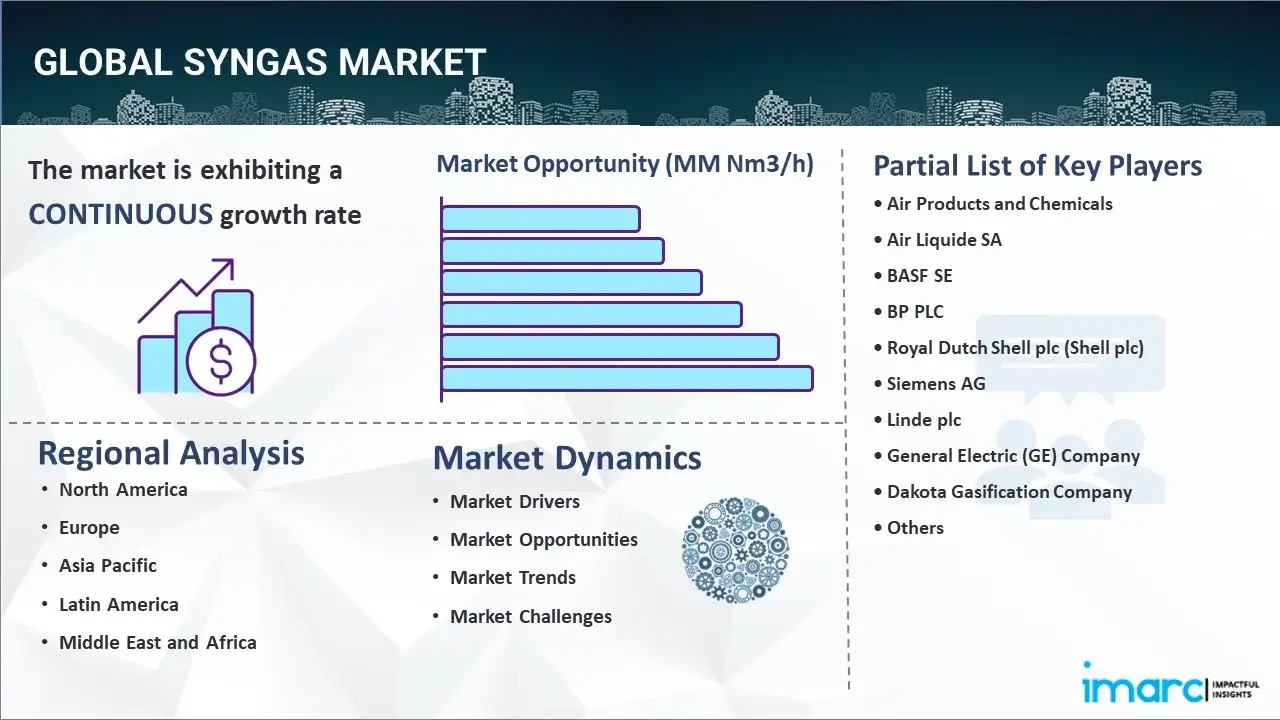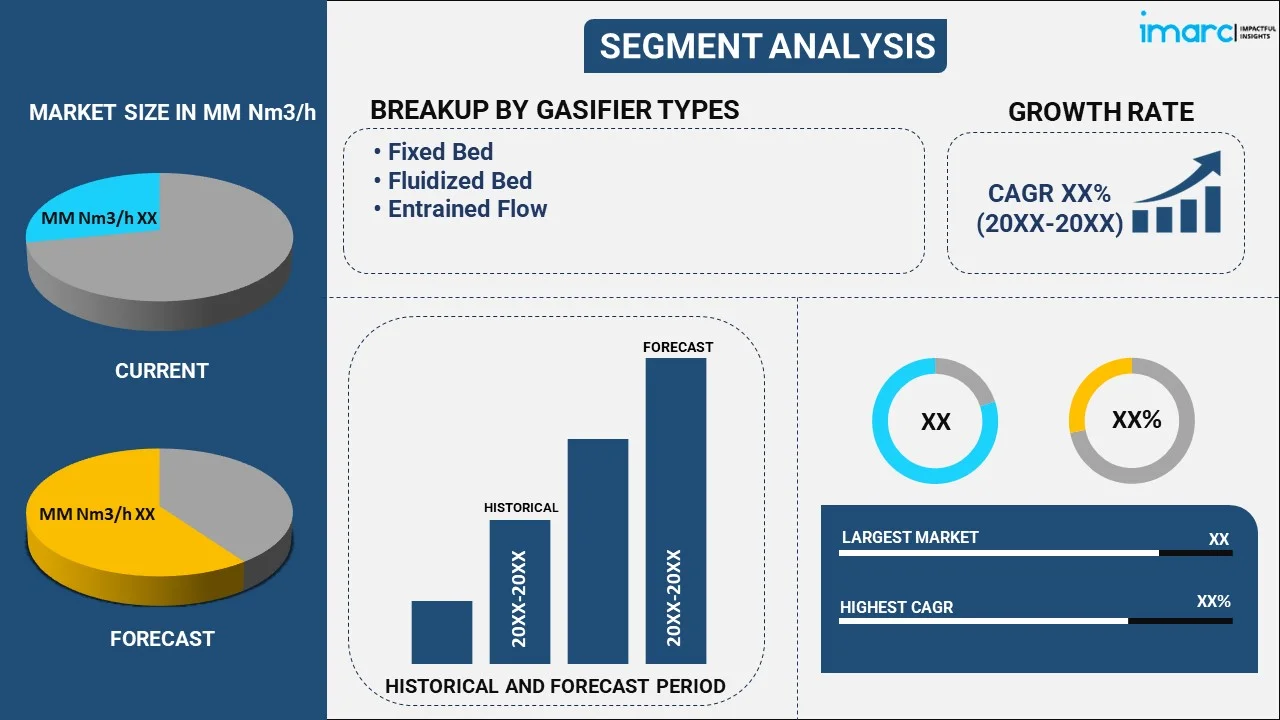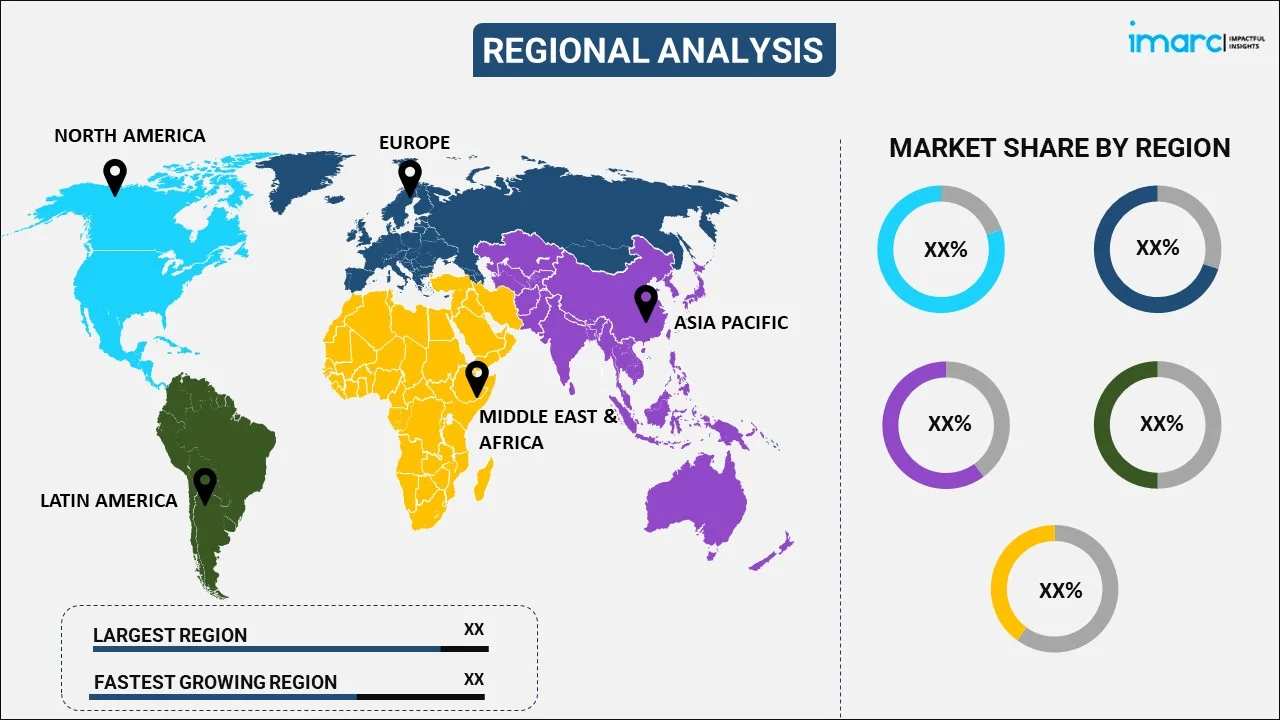
Syngas Market Report by Gasifier Type (Fixed Bed, Fluidized Bed, Entrained Flow), Feedstock (Coal, Natural Gas, Petroleum, Pet-Coke, Biomass and Waste), Technology (Steam Reforming, Partial Oxidation, Combined or Two-Step Reforming, Auto Thermal Reforming, and Others), End-Use (Chemicals, Liquid Fuels, Gaseous Fuels, Power Generation), and Region 2025-2033
Syngas Market Size:
The global syngas market size reached 260.7 MM Nm3/h in 2024. Looking forward, IMARC Group expects the market to reach 554.8 MM Nm3/h by 2033, exhibiting a growth rate (CAGR) of 8.32% during 2025-2033. The market is driven by rising concerns over the availability of conventional energy, regulating greenhouse gases, the development of industrial gasification, and ongoing technological advancements that enhance the efficiency of its production.
|
Report Attribute
|
Key Statistics
|
|---|---|
|
Base Year
|
2024
|
|
Forecast Years
|
2025-2033
|
|
Historical Years
|
2019-2024
|
|
Market Size in 2024
|
260.7 MM Nm3/h |
|
Market Forecast in 2033
|
554.8 MM Nm3/h |
| Market Growth Rate 2025-2033 | 8.32% |
Syngas Market Analysis:
- Major Market Drivers: The syngas market growth is primarily driven by the rising energy needs across the world and the focus on the more environmentally friendly fuel types. In addition, innovation in gasification technologies is fueling market growth by improving the efficiency of syngas generation.
- Key Market Trends: Some of the prevailing trends include increased capital expenditure in renewable syngas production technologies, increasing use of syngas in chemical manufacturing processes to optimize emissions, and efficient biomass gasification technologies for power production.
- Geographical Trends: The s Asia Pacific region currently dominates the syngas market share owing to increased industrialization and infrastructure investment, and government policies that are making a switch to cleaner energy sources due to increasing consciousness about adverse environmental effects.
- Competitive Landscape: Some of the major market players in the syngas industry include Air Products and Chemicals, Air Liquide SA, BASF SE, BP PLC, Royal Dutch Shell plc (Shell plc), Siemens AG, Linde plc, General Electric (GE) Company, Dakota Gasification Company, SynGas Technology LLC, TechnipFMC PLC, OXEA GmbH, Yara International ASA, John Wood Group PLC, ECUST, among many others.
- Challenges and Opportunities: The market faces challenges such as the high fixed cost of investment in generating syngas, and technical difficulties. Moreover, there are vast opportunities for diversifying the uses of syngas in the power generation, chemicals, and transportation fuel segments enhanced by favorable policies, advanced technologies, and the emergence of green energy systems, which in turn has augmented syngas demand.

Syngas Market Trends:
Global Energy Demand and Transition to Cleaner Fuels
The market for syngas is mainly influenced by the energy requirements across the world and the trend that is highly pronounced toward green energy sources. According to the International Energy Agency (IEA), global energy demand is expected to rise by 25% for the period between 2019 and 2040. Currently, national governments are shifting their attention to decreasing the emission of greenhouse gases with goals set under conventions such as the Paris Agreement. This change is promoting the increasing need for syngas as it presents a multi-product intermediate for the generation of renewable energy like hydrogen and synthetic natural gas under the carbon reduction vision.
Advancements in Gasification Technologies
The innovation of new technologies in gasification is also on the list that continues to spur the syngas market forward. Most gasification processes involve a thermal conversion of carbonaceous material into synthesis gas, known as syngas through which chemical reactions occur under specific conditions of temperature. Gasification technologies have advanced in recent years to operate at high efficiency and lower costs, and this makes it possible to utilize in large-scale industries as well as decentralized utility systems. For instance, the U. S Department of Energy (DOE) has indicated new age gasification technologies have the capability of achieving efficiency rates of well over 90 percent thus increasing the efficiencies of energy conversion processes as compared to those of combustion processes. Precision in chemical synthesis and accuracy in the generation of novel materials are central elements in the application of syngas in replacing fossil energy sources in electricity generation and workflow procedures, thus changing the syngas market dynamics.
Government Support and Policies Promoting Clean Energy
Government support and the policies toward clean and renewable energy sources obtained decisive importance for the syngas market growth. Most countries across the globe, therefore, are coming up with policies, incentives, subsidies, and regulation measures to promote the utilization of renewable energy technologies such as the production of syngas. For instance, China stated goals of reaching 15% share of non-fossil fuels in primary energy consumption in 2020 and 20% in 2030. Along with this, the United States has policy measures like the Renewable Fuel Standard and the Investment Tax Credits that aim to utilize renewable fuels produced from syngas. These syngas market insights spur research on syngas technologies, encourage competition within the market, and enhance the implementation of syngas-based energy for the achievement of sustainable development goals internationally.
Syngas Market Segmentation:
IMARC Group provides an analysis of the key trends in each segment of the market, along with forecasts at the global and regional levels for 2025-2033. Our report has categorized the market based on gasifier type, feedstock, technology, and end-use.
Breakup by Gasifier Type:

- Fixed Bed
- Fluidized Bed
- Entrained Flow
Fixed bed accounts for the majority of the market share
The report has provided a detailed breakup and analysis of the market based on the gasifier type. This includes fixed bed, fluidized bed, and entrained flow. According to the report, fixed bed represented the largest segment.
Fixed bed gasification technology dominates the syngas market, which combines biomass and other feedstocks into syngas through a reliable and efficient process. This technology works by fixing a solid material on one of the beds while the other is kept stationary as high-temperature reactions take place within the fixed bed reactor resulting in syngas of carbon monoxide, hydrogen, and methane. For instance, US Department of Energy has recognized fixed bed gasifiers to obtain efficiency levels higher than 80 percent and can be applied both in utility-scale gasification of coals and in distributed generation. This syngas market forecast assurance of a steady flow of production and makes its production economical more so in areas where biomass and waste materials are used as a source of feedstock. Therefore, there is a need to understand and promote the key features of the fixed bed gasification technology that enhances energy conversion efficiency while at the same time minimizing the negative effects on the environment in as much as it supports global sustainability and fight against emissions of greenhouse gases.
Breakup by Feedstock:
- Coal
- Natural Gas
- Petroleum
- Pet-Coke
- Biomass and Waste
Coal holds the largest share of the industry
A detailed breakup and analysis of the market based on the feedstock have also been provided in the report. This includes coal, natural gas, petroleum, pet coke, and biomass and waste. According to the report, coal accounted for the largest market share.
As per the syngas industry report, coal is the most widely used source of syngas since it is readily available and there are already well-developed methods for gasification. Furthermore, the International Energy Agency (IEA) categorizes coal as a key syngas feedstock besides acknowledging that the generation of energy from coal is still popular across the global markets. It is mainly used in gasification technologies due to its high carbon content and relatively cheaper than other feed stocks making it commercially valuable for industrial use. In addition, the growth in efficiency of the coal gasification technologies is evident, this has led to the minimization of adverse effects such as carbon dioxide emissions. Some of the challenges affecting the use of carbon management and environmental issues are still a big driver of coal for the generation of syngas to fulfill the energy needs and to support the intensive energy industries, thus creating a positive syngas industry outlook.
Breakup by Technology:
- Steam Reforming
- Partial Oxidation
- Combined or Two-Step Reforming
- Auto Thermal Reforming
- Others
Steam reforming represents the leading market segment
The report has provided a detailed breakup and analysis of the market based on the technology. This includes steam reforming, partial oxidation, combined or two-step reforming, auto-thermal reforming, and others. According to the report, steam reforming represented the largest segment.
Steam reforming drives the syngas market revenue due to product distribution and the ease at which the process can be implemented in hydrogen and ammonia production. As reported by the U. S. Department of Energy (DOE), steam methane reforming, or SMR, is one of the leading technologies in the production of hydrogen commercially and relies on natural gas feedstock. SMR is chosen for its efficiency in converting methane to syngas where hydrogen generated has a purity of over 99%. This process is well-defined & its operating cost is low, hence is easily implementable in large-scale sectors such as petrochemicals & refineries, etc. Also, improvements have been observed in SMR technologies regarding energy efficiency, including the emissions of greenhouse gases by capturing and utilizing carbon.
Breakup by End-Use:
- Chemicals
- Ammonia
- Gas to liquid
- Hydrogen
- Methanol
- N-Butanol
- Dimethyl Ether
- Liquid Fuels
- Gaseous Fuels
- Power Generation
Chemicals exhibits a clear dominance in the market
A detailed breakup and analysis of the market based on the end use have also been provided in the report. This includes chemicals (ammonia, gas to liquid, hydrogen, methanol, n-butanol, dimethyl ether), liquid fuels, gaseous fuels, and power generation. According to the report, chemicals accounted for the largest market share.
Chemicals hold the largest market share and drive the syngas market value owing to their usage in the manufacturing of different chemical products. For instance, the International Energy Agency (IEA) has identified syngas as a vital intermediate in the transformations of several chemicals including methanol and ammonia. For example, methanol production takes a large slice of syngas consumption worldwide; with uses extending from as a blending ingredient in fuels, to as a feedstock in making plastics, drugs, and others. The fact that syngas is variable in chemical synthesis is supported by the presence of its two main components of hydrogen and carbon monoxide: both are basic to an extensive assortment of industrial processes. This is due to the global usage of chemicals in industries including automotive, construction, and electronics among others has been rising in recent years propelling the need for syngas as a vital commodity that supports industrial development globally.
Breakup by Region:

- Asia Pacific
- Europe
- North America
- Middle East and Africa
- Latin America
Asia Pacific leads the market, accounting for the largest syngas market share
The report has also provided a comprehensive analysis of all the major regional markets, which include Asia-Pacific, Europe, North America, Middle East and Africa, and Latin America. According to the report, Asia Pacific was the largest regional market for syngas.
Syngas market research report highlights the dominance of Asia Pacific owing to industrialization, huge investment in energy plants, and governmental support in clean energy projects. As estimated by the IEA, the Asia Pacific region currently stands as the biggest consumer of energy in the global market, China and India are major consumers of syngas. For instance, China has set a long-term plan in its 13th Five-Year Plan to bring the proportion of non-fossil energy consumption in the country’s primary energy to about 20 percent by 2030. These emphasize lowering greenhouse gas emissions and improving energy security and thus have accelerated the investment in syngas technologies mainly on biomass and coal gasification. Along with this, more and more Southeast Asian countries are transforming their power generation portfolios to lean on renewable resources adding to the use of Syngas for clean energy production.
Competitive Landscape:
- The market research report has also provided a comprehensive analysis of the competitive landscape in the market. Detailed profiles of all major companies have also been provided. Some of the major market players in the syngas industry include Air Products and Chemicals, Air Liquide SA, BASF SE, BP PLC, Royal Dutch Shell plc (Shell plc), Siemens AG, Linde plc, General Electric (GE) Company, Dakota Gasification Company, SynGas Technology LLC, TechnipFMC PLC, OXEA GmbH, Yara International ASA, John Wood Group PLC, and ECUST.
(Please note that this is only a partial list of the key players, and the complete list is provided in the report.)
- Market players in the syngas segment are focusing on developing new technologies as well as increasing production capabilities to address the ever-increasing global need for clean energy sources. Air Liquide, Air Products and Chemicals, and Shell, among others, are therefore increasingly investing in innovative gasification technologies that positively impact efficiency and emission of carbon. For instance, Air Liquide has pursued forward integration by investing in biomass gasification projects to create syngas for hydrogen and synthetic fuels. According to the International Energy Agency (IEA), global investment in energy technologies needs to increase to around $2.7 trillion per year by 2030 to achieve climate goals, highlighting the industry's commitment to scaling up renewable energy sources such as syngas. These investments or innovations are fostering a favorable syngas market outlook.
Syngas Market News:
- In September 2023, BASF broke ground on a syngas plant at its Zhanjiang Verbund site in China, aiming to enhance production capabilities and meet rising demand for syngas in the region.
- In January 2024, Welsh produced "over 95% purity hydrogen" from waste-generated syngas, showcasing advancements in syngas technology for sustainable hydrogen production from renewable sources.
Syngas Market Report Scope:
| Report Features | Details |
|---|---|
| Base Year of the Analysis | 2024 |
| Historical Period | 2019-2024 |
| Forecast Period | 2025-2033 |
| Units | MM Nm3/h |
| Scope of the Report | Exploration of Historical Trends and Market Outlook, Industry Catalysts and Challenges, Segment-Wise Historical and Future Market Assessment:
|
| Gasifier Types Covered | Fixed Bed, Fluidized Bed, Entrained Flow |
| Feedstocks Covered | Coal, Natural Gas, Petroleum, Pet-Coke, Biomass and Waste |
| Technologies Covered | Steam Reforming, Partial Oxidation, Combined or Two-Step Reforming, Auto Thermal Reforming, Others |
| End Uses Covered |
|
| Regions Covered | Asia Pacific, Europe, North America, Latin America, Middle East and Africa |
| Companies Covered | Air Products and Chemicals, Air Liquide SA, BASF SE, BP PLC, Royal Dutch Shell plc (Shell plc), Siemens AG, Linde plc, General Electric (GE) Company, Dakota Gasification Company, SynGas Technology LLC, TechnipFMC PLC, OXEA GmbH, Yara International ASA, John Wood Group PLC, ECUST, etc. |
| Customization Scope | 10% Free Customization |
| Post-Sale Analyst Support | 10-12 Weeks |
| Delivery Format | PDF and Excel through Email (We can also provide the editable version of the report in PPT/Word format on special request) |
Key Questions Answered in This Report:
- How has the global syngas market performed so far, and how will it perform in the coming years?
- What are the drivers, restraints, and opportunities in the global syngas market?
- What is the impact of each driver, restraint, and opportunity on the global syngas market?
- What are the key regional markets?
- Which countries represent the most attractive syngas market?
- What is the breakup of the market based on the gasifier type?
- Which is the most attractive gasifier type in the syngas market?
- What is the breakup of the market based on the feedstock?
- Which is the most attractive feedstock in the syngas market?
- What is the breakup of the market based on technology?
- Which is the most attractive technology in the syngas market?
- What is the breakup of the market based on the end use?
- Which is the most attractive end-use in the syngas market?
- What is the competitive structure of the market?
- Who are the key players/companies in the global syngas market?
Key Benefits for Stakeholders:
- IMARC’s industry report offers a comprehensive quantitative analysis of various market segments, historical and current market trends, market forecasts, and dynamics of the syngas market from 2019-2033.
- The research report provides the latest information on the market drivers, challenges, and opportunities in the global syngas market.
- The study maps the leading, as well as the fastest-growing, regional markets.
- Porter's five forces analysis assists stakeholders in assessing the impact of new entrants, competitive rivalry, supplier power, buyer power, and the threat of substitution. It helps stakeholders to analyze the level of competition within the syngas industry and its attractiveness.
- The competitive landscape allows stakeholders to understand their competitive environment and provides insight into the current positions of key players in the market.
Need more help?
- Speak to our experienced analysts for insights on the current market scenarios.
- Include additional segments and countries to customize the report as per your requirement.
- Gain an unparalleled competitive advantage in your domain by understanding how to utilize the report and positively impacting your operations and revenue.
- For further assistance, please connect with our analysts.
 Inquire Before Buying
Inquire Before Buying
 Speak to an Analyst
Speak to an Analyst
 Request Brochure
Request Brochure
 Request Customization
Request Customization




.webp)




.webp)












